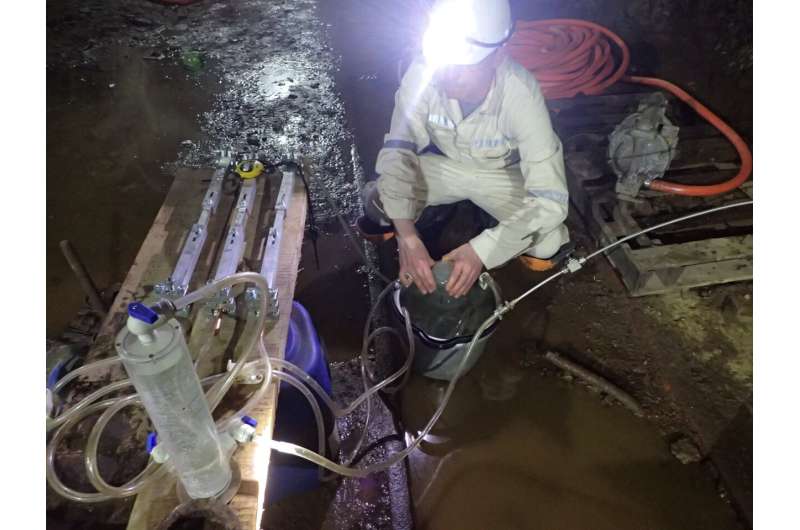An international team of researchers has discovered 1.2-billion-year-old groundwater deep in a gold- and uranium-producing mine in Moab Khotsong, South Africa, shedding more light on how life is sustained below the Earth’s surface and how it may thrive on other planets.
The findings were published earlier this week in the journal Nature Communications.
“For the first time, we have insight into how energy stored deep in the Earth’s subsurface can be released and distributed more broadly through its crust over time,” says Oliver Warr, research associate in the Department of Earth Sciences at the University of Toronto and lead author of the study. “Think of it as a Pandora’s Box of helium-and-hydrogen-producing power, one that we can learn how to harness for the benefit of the deep biosphere on a global scale.”
“Ten years ago, we discovered billion-year-old groundwater from below the Canadian Shield—this was just the beginning, it seems,” says Barbara Sherwood Lollar, professor in the Department of Earth Sciences at the University of Toronto and corresponding author. “Now, 2.9 km below the Earth’s surface in Moab Khotsong, we have found that the extreme outposts of the world’s water cycle are more widespread than once thought.”
Uranium and other radioactive elements naturally occur in the surrounding host rock that contains mineral and ore deposits. These elements hold new information about the groundwater’s role as a power generator for chemolithotrophic (or rock-eating) groups of cohabitating microorganisms previously discovered in the Earth’s deep subsurface. When elements like uranium, thorium and potassium decay in the subsurface, the resulting alpha, beta, and gamma radiation has ripple effects, triggering what are called radiogenic reactions in the surrounding rocks and fluids.
At Moab Khotsong, the researchers found large amounts of radiogenic helium, neon, argon and xenon, and an unprecedented discovery of an isotope of krypton—a never-before-seen tracer of this powerful reaction history. The radiation also breaks apart water molecules in a process called radiolysis, producing large concentrations of hydrogen, an essential energy source for subsurface microbial communities deep in the Earth that are unable to access energy from the sun for photosynthesis.
Due to their extremely small masses, helium and neon are uniquely valuable for identifying and quantifying transport potential. While the extremely low porosity of crystalline basement rocks in which these waters are found means the groundwaters themselves are largely isolated and rarely mix, accounting for their 1.2-billion-year age, diffusion can still take place.

Researcher Oliver Warr collecting sample in Moab Khotsong, South Africa. © Oliver Warr
“Solid materials such as plastic, stainless steel and even solid rock are eventually penetrated by diffusing helium, much like the deflation of a helium-filled balloon,” says Warr. “Our results show that diffusion has provided a way for 75 to 82 percent of the helium and neon originally produced by the radiogenic reactions to be transported through the overlying crust.”
The researchers stress that the study’s new insights on how much helium diffuses up from the deep Earth is a critical step forward, as global helium reserves run out, and the transition to more sustainable resources gains traction.
“Humans are not the only life-forms relying on the energy resources of the Earth’s deep subsurface,” says Warr. “Since the radiogenic reactions produce both helium and hydrogen, we can not only learn about helium reservoirs and transport, but also calculate hydrogen energy flux from the deep Earth that can sustain subsurface microbes on a global scale.”
Warr notes that these calculations are vital for understanding how subsurface life is sustained on Earth, and what energy might be available from radiogenic-driven power on other planets and moons in the solar system and beyond, informing upcoming missions to Mars, Titan, Enceladus and Europa.
Additional co-authors of the paper include C.J. Ballentine from the University of Oxford, and researchers from Princeton University and the New Mexico Institute of Mining and Technology.
More information:
O. Warr et al, 86Kr excess and other noble gases identify a billion-year-old radiogenically-enriched groundwater system, Nature Communications (2022). DOI: 10.1038/s41467-022-31412-2
Provided by
University of Toronto
Citation:
Researchers uncover life’s power generators in the Earth’s oldest groundwaters (2022, July 5)


